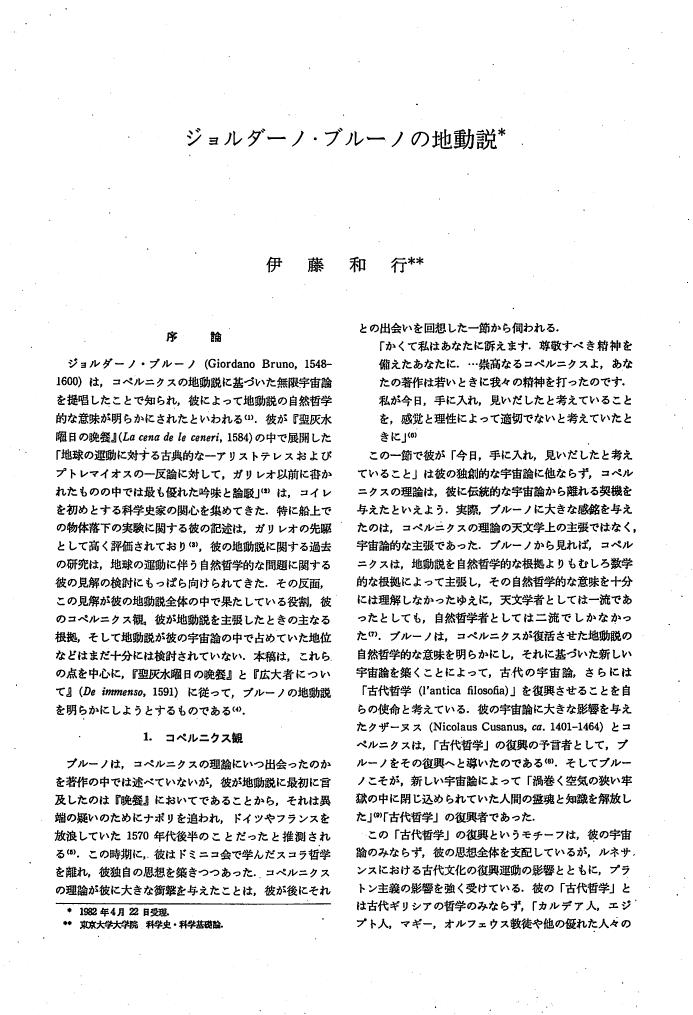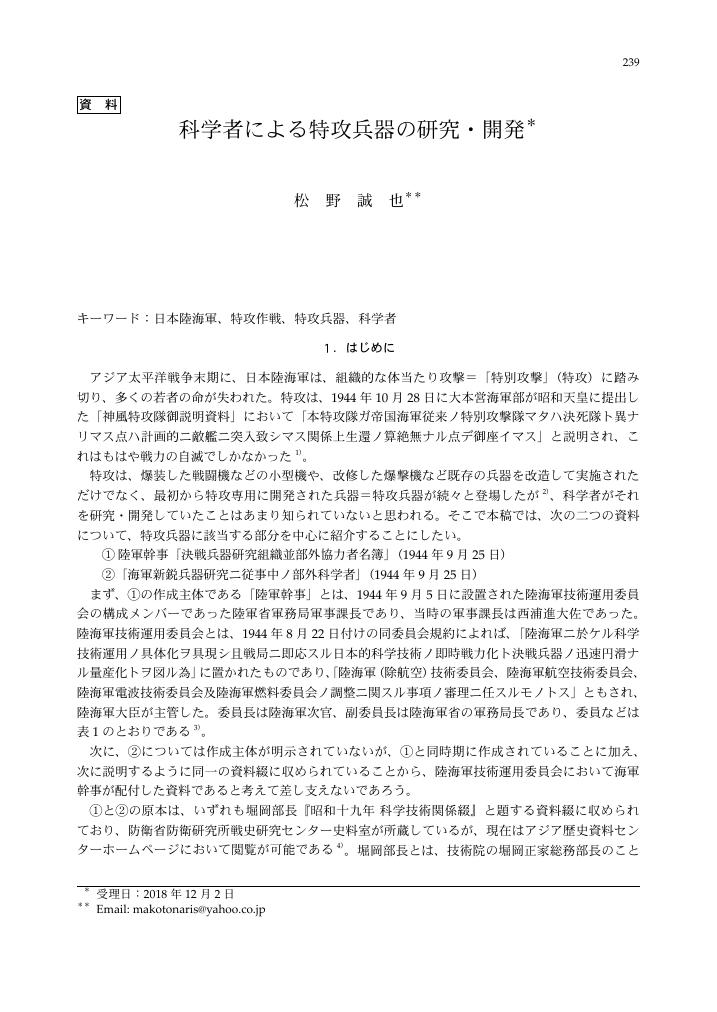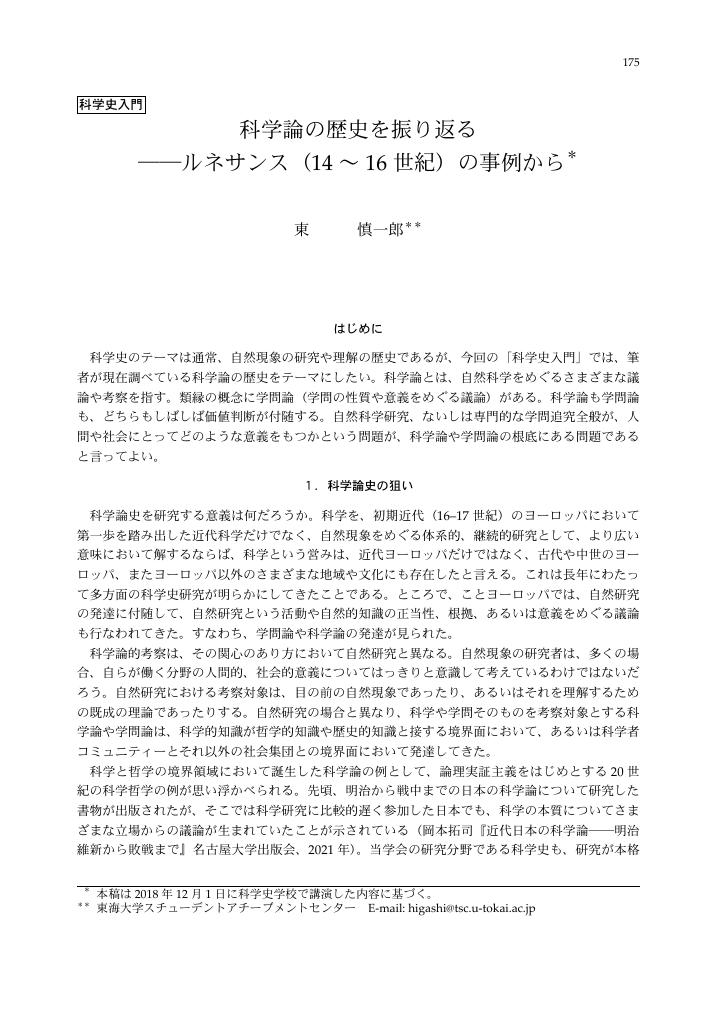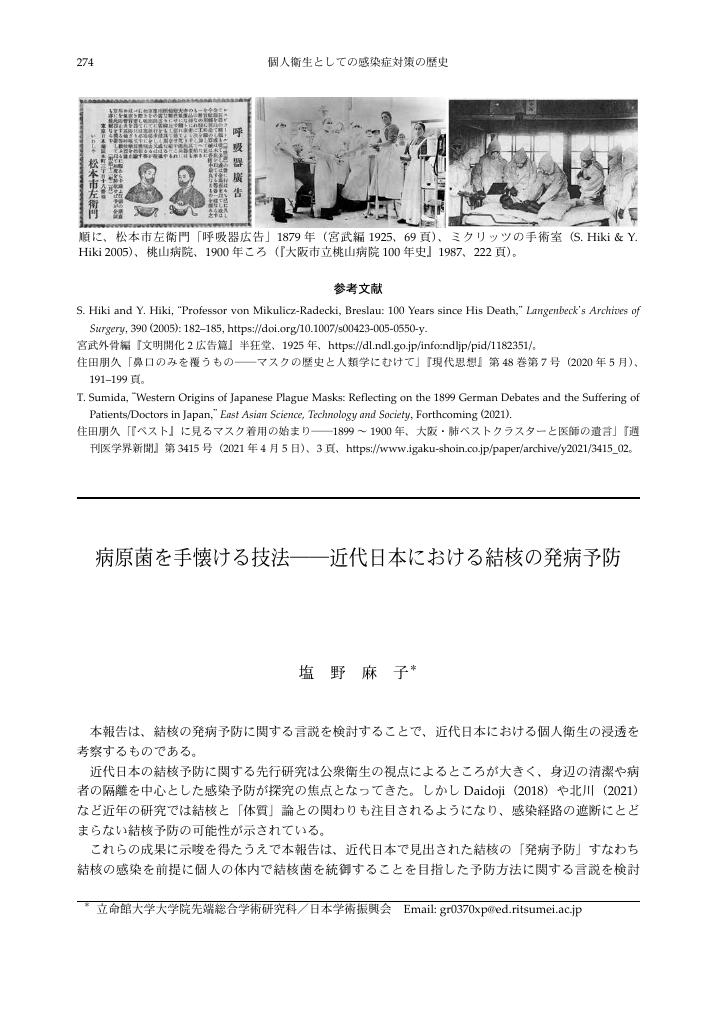3 0 0 0 OA 外国における"血液型パーソナリティの関係"をめぐる研究
- 著者
- 溝口 元
- 出版者
- 日本科学史学会
- 雑誌
- 科学史研究 (ISSN:21887535)
- 巻号頁・発行日
- vol.32, no.187, pp.152-156, 1993 (Released:2021-03-23)
3 0 0 0 OA ジョルダーノ・ブルーノの地動説
- 著者
- 伊藤 和行
- 出版者
- 日本科学史学会
- 雑誌
- 科学史研究 (ISSN:21887535)
- 巻号頁・発行日
- vol.21, no.142, pp.81-87, 1982 (Released:2021-05-13)
3 0 0 0 OA 曲直瀬道三撰『医心正伝』の研究 : 「察証弁治」形成の過程とその変遷
- 著者
- 遠藤 次郎 鈴木 琢也 中村 輝子
- 出版者
- 日本科学史学会
- 雑誌
- 科学史研究 (ISSN:21887535)
- 巻号頁・発行日
- vol.41, no.223, pp.129-137, 2002 (Released:2021-08-13)
Sanki Tashiro and Dosan Manase are known for their role as founders of the Gosei-ha school in Japan. Observing that Japanese medicine had not been based on a clear theory, they introduced into Japan the satsusho benchi practiced in Chinese medicine during the Jin and Yuan dynasties. The basis of this system was to examine the patient's condition, then determine the treatment accordingly. Dosan Manase in particular employed the satsusho benchi, writing out a new prescription each time treatment was required, without reference to existing prescriptions. In this study, we carried out an investigation into the "Ishin shoden" edited by Dosan Manase, which reveals the process by which Dosan established the new satsusho benchi system of medicine within the framework of traditional Japanese medicine. In the early stages of the process, Dosan prepared prescriptions based on existing iou-tou prescriptions, modifying these by adding or removing medicines. Then, in the middle period, he prepared prescriptions based on toso-tou prescriptions, designed on the basis of the kun shin sa shi or Junchen Zuoshi theory, again modifying these by adding or removing medicines. In the final stage of the process, Dosan ceased this practice of adding or removing medicines from a basic prescription, adopting instead the satsusho benchi system of writing out a new prescription for every treatment. In addition, we consider the reasons why the satsusho benchi system was not employed by Dosan's successors, and discuss the effects of this.
3 0 0 0 OA 科学者による特攻兵器の研究・開発
- 著者
- 松野 誠也
- 出版者
- 日本科学史学会
- 雑誌
- 科学史研究 (ISSN:21887535)
- 巻号頁・発行日
- vol.58, no.291, pp.239-248, 2019 (Released:2021-01-24)
3 0 0 0 OA デュアルユース発明の秘密特許化 : 民生産業における懸念
- 出版者
- 日本科学史学会
- 雑誌
- 科学史研究 (ISSN:21887535)
- 巻号頁・発行日
- vol.60, no.299, pp.234, 2021 (Released:2022-08-01)
3 0 0 0 OA 旧制第一高等学校に学んだ初期京師大学堂派遣の清国留学生について
- 著者
- 薩 日娜
- 出版者
- 日本科学史学会
- 雑誌
- 科学史研究 (ISSN:21887535)
- 巻号頁・発行日
- vol.49, no.256, pp.216-226, 2010 (Released:2021-07-22)
This paper investigates the activities of early Chinese students who were dispatched by the Imperial University of Peking (京師大学堂) to the First High School (第一高等学校) in Japan. It is based on original sources which remain partly unsorted. First, the correspondence between the Late Qing's minister of Education Zhang Baixi (張百煕) and the Imperial University of Peking's Japanese teacher Hattori Unokichi (服部宇之吉) will be analyzed, which reveals details about motives and circumstances of the dispatch project. Secondly, documents preserved at the University of Tokyo show the study life and, in particular, mathematics education offered to the foreign students in the First High School. Thirdly, the contribution of the whole project to the modernization of mathematics, natural science and technology in China will be examined, on the basis of achievements of those students after their return.
3 0 0 0 OA 博物図譜でたどる明治の科学系博物館資料(科学史入門)
- 著者
- 原田 紀子
- 出版者
- 日本科学史学会
- 雑誌
- 科学史研究 (ISSN:21887535)
- 巻号頁・発行日
- vol.43, no.231, pp.161-164, 2004 (Released:2021-08-12)
3 0 0 0 OA 冷戦期アメリカの対日外交政策と日本のテレビジョン放送導入
- 著者
- 奥田 謙造
- 出版者
- 日本科学史学会
- 雑誌
- 科学史研究 (ISSN:21887535)
- 巻号頁・発行日
- vol.46, no.241, pp.1-13, 2007 (Released:2021-08-11)
The plans for TV broadcasting emerged in Japan when Japan and the US began to negotiate a peace. There were two institutions in Japan that promoted TV broadcasting : NHK, a public radio broadcasting station, and Yomiuri Shinbun, a private daily owned by Shoriki Matsutato. At that time the US was looking for new allies and new ways to block the spread of communism. Then American politicians such as Senator Karl Mundt came to understand that television was a useful tool of psychological warfare against communism. When Hidetoshi Shibata, one of Shoriki's best confidants, found a news report of Mundt's "Vision of America " proposal in the US Senate Congress, he thought that it was a good opportunity for giving a push to a scheme for a new Japanese TV broadcasting. Shibata visited the US in April 1951, met Mundt and others, and asked for their support to Yomiuri's plan. Soon after that Shoriki established Nippon Television Network Corporation (NTV), and invited American TV consultants to Japan. They argued that the Japanese TV system should adopt the American TV standards. In September the Sun Francisco Conference was held for the Treaty of Peace with Japan that led to the termination of the occupation. A report of the US State Department one month after the conference said that Japanese supported the American standards for implementation of the peace treaty and defensive alliance, and by television the Japanese nation would be welded into a democratic ally of the US. With the American standards NHK began its TV broadcasting service in February 1953, and NTV, in August.
3 0 0 0 OA 科学論の歴史を振り返る : ルネサンス(14~16世紀)の事例から
- 出版者
- 日本科学史学会
- 雑誌
- 科学史研究 (ISSN:21887535)
- 巻号頁・発行日
- vol.60, no.298, pp.175-181, 2021 (Released:2022-08-01)
3 0 0 0 OA 円周率3.14の動揺と3.16の復活の謎
- 著者
- 中村 邦光 板倉 聖宣
- 出版者
- 日本科学史学会
- 雑誌
- 科学史研究 (ISSN:21887535)
- 巻号頁・発行日
- vol.23, no.151, pp.140, 1984 (Released:2021-04-07)
3 0 0 0 OA 原子爆弾と戦争廃絶・放棄論1945~1946
- 著者
- 山崎 正勝
- 出版者
- 日本科学史学会
- 雑誌
- 科学史研究 (ISSN:21887535)
- 巻号頁・発行日
- vol.58, no.290, pp.162-177, 2019 (Released:2021-01-24)
The "Russell-Einstein Manifesto" issued in 1955, a year after the Bikini incident, called upon the world for the abolition of nuclear weapons and war. It is well known that a similar assertion was made in a journal article in 1946 by Yoshio Nishina, one of Japanʼs prominent nuclear physicists who officially studied the damage of the atomic bombings of Hiroshima and Nagasaki. This paper shows that there were a wide range of arguments in Japan for the abolition and/or renunciation of war in the immediate aftermath of the atomic bombings. Naruhiko Higashikuni, the first Prime Minister after Japanʼs surrender, suggested the idea of "Peaceful Country Japan [Heiwa kokka Nippon]." Tanzan Ishibashi, an influential journalist and future Prime Minister in the 1950s, witnessed a drastic change in international relations caused by the atomic bomb, calling for Japan to become a "warrior for world peace [Sekai heiwa no senshi]." Kanji Ishihara, a former Army lieutenant general and military philosopher, understood that the emergence of atomic bombs and the pursuit of world peace under the United Nations after World War II as a sign of "world political unity [seijiteki sekai toitsu]" that he had anticipated prior to the war. Realizing that the atomic bomb had changed the way of war, Kijuro Shidehara, Prime Minister after Higashikuni, spoke to Supreme Commander of the Allied Forces Douglas MacArthur of the necessity of abolishing and renouncing war. MacArthur incorporated this idea into his demands concerning Japanʼs constitutional revision. All these individuals foresaw the meaning of Article 9 of the Japanese Constitution in the context of the nuclear age, hoping that Japan would be a pioneer of war abolition and renouncement.
3 0 0 0 OA 病原菌を手懐ける技法――近代日本における結核の発病予防
- 出版者
- 日本科学史学会
- 雑誌
- 科学史研究 (ISSN:21887535)
- 巻号頁・発行日
- vol.60, no.299, pp.274, 2021 (Released:2022-08-01)
3 0 0 0 OA NASAとアポロ計画(科学史入門)
- 著者
- 佐藤 靖
- 出版者
- 日本科学史学会
- 雑誌
- 科学史研究 (ISSN:21887535)
- 巻号頁・発行日
- vol.49, no.253, pp.22-25, 2010 (Released:2021-08-02)
3 0 0 0 OA マントヴァのガリレオ
- 著者
- 田中 一郎
- 出版者
- 日本科学史学会
- 雑誌
- 科学史研究 (ISSN:21887535)
- 巻号頁・発行日
- vol.48, no.250, pp.120-123, 2009 (Released:2021-08-04)
3 0 0 0 OA コントと生物学者たち
- 著者
- 金森 修
- 出版者
- 日本科学史学会
- 雑誌
- 科学史研究 (ISSN:21887535)
- 巻号頁・発行日
- vol.33, no.189, pp.7-14, 1994 (Released:2021-03-22)
3 0 0 0 OA 初期ガリレオにおける の法則と加速運動
- 著者
- 山崎 正勝
- 出版者
- 日本科学史学会
- 雑誌
- 科学史研究 (ISSN:21887535)
- 巻号頁・発行日
- vol.29, no.175, pp.167-171, 1990 (Released:2021-08-30)
In his letter to Guidobardo Del Monte in 1602, Galileo Galilei claims that he derives the law of conjugate chords, Prop. 36 in Two New Sciences III. M. Yoshinaka, W. L. Wisan and S. Ito suggest that Galileo obtains the law of conjugate chords from the mean proportional theorem just like in Two New Sciences. In this paper it is shown that the law of conjugate chords can be derived from the theorem of De Motu. The historical significance of the laws of chords and conjugate chords is discussed and it is maintained that these laws are the link that joined old Aristotelian to new Newtonian dynamics.
3 0 0 0 OA 新島襄と科学
- 著者
- 島尾 永康
- 出版者
- 日本科学史学会
- 雑誌
- 科学史研究 (ISSN:21887535)
- 巻号頁・発行日
- vol.25, no.158, pp.83-88, 1986 (Released:2021-04-05)
3 0 0 0 OA 『物理階梯』の編者片山淳吉の生涯
- 著者
- 岡本 正志
- 出版者
- 日本科学史学会
- 雑誌
- 科学史研究 (ISSN:21887535)
- 巻号頁・発行日
- vol.24, no.154, pp.84-94, 1985 (Released:2021-04-07)
3 0 0 0 OA 科学史入門 なぜ石原純か
- 著者
- 西尾 成子
- 出版者
- 日本科学史学会
- 雑誌
- 科学史研究 (ISSN:21887535)
- 巻号頁・発行日
- vol.57, no.287, pp.226-233, 2018 (Released:2021-01-24)
- 著者
- 坂本 邦暢
- 出版者
- 日本科学史学会
- 雑誌
- 科学史研究. 第II期 (ISSN:00227692)
- 巻号頁・発行日
- vol.50, no.257, pp.31-36, 2011-03-25
- 被引用文献数
- 2
Francis Bacon was a major early modern critic of Aristotelianism. In addressing its matter theory, he mainly attacked the concept of prime matter, which, for many Aristotelians, was deprived of any attribute. He denied this doctrine on the basis of the inseparability of matter from its quantity and power. By examining theological and natural philosophical dimensions of this idea, this paper reveals the close interconnection among various fields of knowledge in Bacon's thought.













